
Adolph Fischer was an anarchist and labor union activist tried and executed after the Haymarket Riot.

A police riot is a riot carried out by the police; more specifically, it is a riot that police are responsible for instigating, escalating or sustaining as a violent confrontation. Police riots are often characterized by widespread police brutality, and they may be done for the purpose of political repression.

Pace is the suburban bus and regional paratransit division of the Regional Transportation Authority serving the Chicago metropolitan area. It was created in 1983 by the RTA Act, which established the formula that provides funding to the CTA, Metra, and Pace. The various agencies providing bus service in the Chicago suburbs were merged under the Suburban Bus Division, which rebranded as Pace in 1984. In 2022, Pace had 18.041 million riders.

The Near West Side, one of the 77 community areas of Chicago, is on the West Side, west of the Chicago River and adjacent to the Loop. The Great Chicago Fire of 1871 started on the Near West Side. Waves of immigration shaped the history of the Near West Side of Chicago, including the founding of Hull House, a prominent settlement house. In the 19th century railroads became prominent features. In the mid-20th century, the area saw the development of freeways centered in the Jane Byrne Interchange.
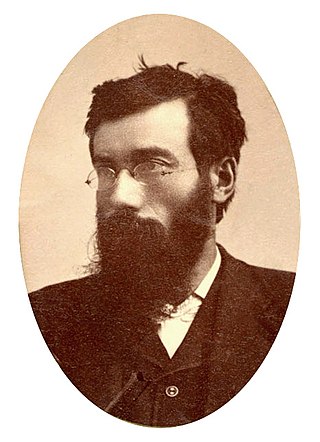
Michael Schwab was a German-American labor organizer and one of the defendants in the Haymarket Square incident.
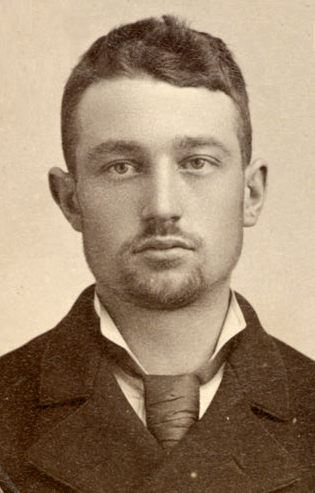
Louis Lingg was a German-born American anarchist who was wrongfully convicted as a member of the criminal conspiracy behind the 1886 Haymarket Square bombing. Lingg was sentenced to die by hanging, but shortly before his execution, he committed suicide in his cell using an explosive. In 1893, Illinois Governor John Altgeld granted Lingg a posthumous pardon, stating that he and the other seven men who had been convicted were innocent of the charges.
The May Day riots of 1894 were a series of violent demonstrations that occurred throughout Cleveland, Ohio on May 1, 1894. Cleveland's unemployment rate increased dramatically during the Panic of 1893. Finally, riots broke out among the unemployed who condemned city leaders for their ineffective relief measures. According to the New York Times, "[t]he desire to stop work seemed to take possession of every laborer..." on May Day of 1894.
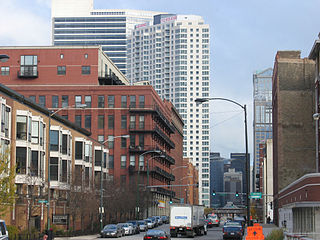
Fulton River District is a Chicago neighborhood located on the edge of Chicago's downtown, northwest of the Loop. The district is bounded by the Chicago River to the east, the Kennedy Expressway to the west, Ohio Street to the north and Madison Street to the south, making it part of the Near West Side and West Town community areas of Chicago in Cook County, Illinois, United States. Just across the expressway to the west is the Fulton Market District. Money magazine ranked the neighborhood as #4 best place to live in the United States in 2019.

Market Square is a market square in Providence, Rhode Island. It is located at the intersection of present-day North Main Street and College Street at the base of College Hill. Market Square has historically functioned as a commercial, civic, and cultural locus of Providence.

The Haymarket affair, also known as the Haymarket massacre, the Haymarket riot, the Haymarket Square riot, or the Haymarket Incident, was the aftermath of a bombing that took place at a labor demonstration on May 4, 1886, at Haymarket Square in Chicago, Illinois, United States. The rally began peacefully in support of workers striking for an eight-hour work day, the day after the events at the McCormick Harvesting Machine Company, during which one person was killed and many workers injured. An unknown person threw a dynamite bomb at the police as they acted to disperse the meeting, and the bomb blast and ensuing retaliatory gunfire by the police caused the deaths of seven police officers and at least four civilians; dozens of others were wounded.

Lafayette Square is a seven-acre public park located within President's Park in Washington, D.C., directly north of the White House on H Street, bounded by Jackson Place on the west, Madison Place on the east and Pennsylvania Avenue on the south. It is named for the Marquis de Lafayette, a French aristocrat and hero of the American Revolutionary War (1775–1783) and includes several statues of revolutionary heroes from Europe, including Lafayette, and at its center a famous statue of early 19th century U.S. president and general Andrew Jackson on horseback with both of the horse's front hooves raised.
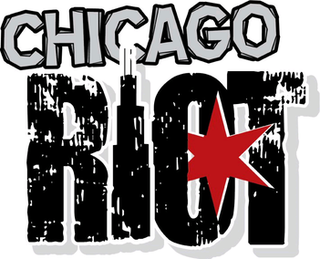
The Chicago Riot was an indoor soccer team that played in the Major Indoor Soccer League. They were based in Villa Park, Illinois, near Chicago, and they played their home games at the Odeum Expo Center.
There are several monuments to commemorate the Haymarket affair.

As a reaction to the murder of George Floyd on May 25, 2020, racial justice activists and some residents of the Powderhorn community in Minneapolis staged an occupation protest at the intersection of East 38th Street and Chicago Avenue with a blockade of the streetway lasting over a year. The street intersection is where Derek Chauvin, a White police officer with the Minneapolis Police Department, murdered George Floyd, an unarmed 46-year-old Black man. Activists erected barricades to block vehicular traffic and transformed the street intersection and surrounding structures with amenities, social services, and public art of Floyd and that of other racial justice themes. The community referred to the unofficial memorial and protest zone at the street intersection as "George Floyd Square". The controversial street occupation in 2020 and 2021 was described as an “autonomous” zone and a "no-go" place for police, but local officials disputed the extent of such characterizations.
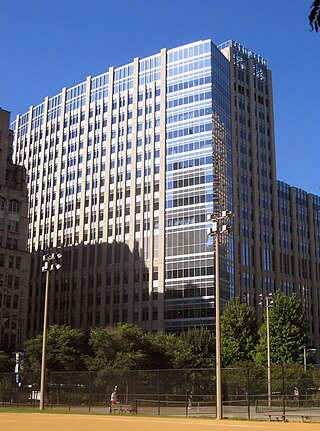
Prentice Women's Hospital is an acute care women's hospital located adjacent to both Northwestern Memorial and the Lurie Children's Hospital, in Chicago, Illinois, United States. Prentice Women's Hospital is a member of Northwestern Medicine and serves as a teaching hospital for the Northwestern University Feinberg School of Medicine. The hospital provides tertiary-level obstetric, gynecological, and neonatal care to patients from the entire region. The hospital has 256 beds, with 86 AAP verified level III neonatal intensive care unit beds, 32 labor and delivery beds, 86 healthy bassinets, and 10 operating rooms. The hospital is directly attached to the Lurie Children's Hospital via skybridge because Lurie physicians provide care on Prentice's neonatal intensive care units.

George Floyd Square, officially George Perry Floyd Square, is the commemorative street name for the section of Chicago Avenue in the U.S. city of Minneapolis from East 37th Street to East 39th Street. It is named after George Floyd, a Black man who was murdered there by Minneapolis police officer Derek Chauvin on May 25, 2020. The streetway and memorial site is centered at the 38th and Chicago intersection.
George Floyd was an African American man who was murdered by a Minneapolis police officer on May 25, 2020. He was memorialized via events, protests, artwork installations, organizations, official designations, and campaigns.

















